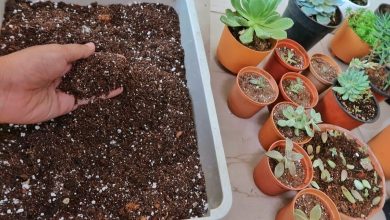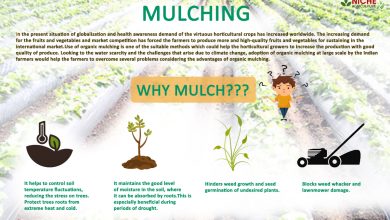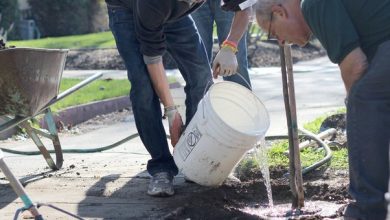Growing tomatoes step by step: How to plant tomatoes in the garden
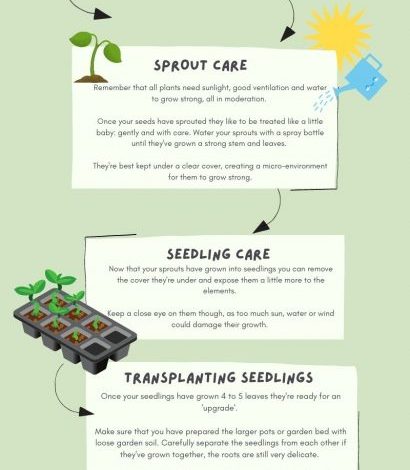
We have already seen in various articles in the “How to make a garden” category some of the most important aspects of garden planning and cultivation. Now we are going to focus on some of the most cultivated plants in the garden for consumption in our home. We will start, with this post, giving more details on how to grow tomatoes in the garden. Tomatoes are the most cultivated vegetable in Spain and one of the most used in the kitchen!
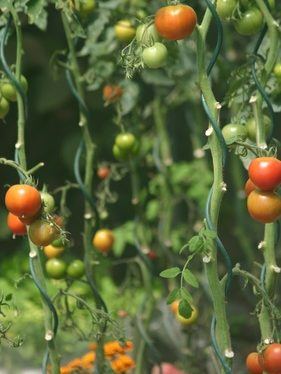
But before learning how to grow tomatoes, we will see what the most important characteristics and requirements of this plant are.
Characteristics and requirements
The tomato is a fruit-bearing nightshade (and therefore quite demanding in nutrients), with a short main root and a large “network” of secondary roots.
You must take this into account when planning the possible associations and crop rotations of your organic garden. For example, the tomato is compatible with undemanding plants with a small root system, such as chard, basil, garlic, onion, cabbage, escarole, lettuce or leek. On the contrary, you should avoid growing tomatoes together with other nightshades such as aubergines or peppers, cucurbits such as squash or cucumber, or potatoes, as they have similar requirements and will compete for nutrients in the soil and for water.
In addition, aromatic plants such as mint or basil go very well with solanaceous plants such as tomatoes or peppers because, with their smell, they help repel pests of these vegetables.
There are many varieties of tomatoes, you can see some and also tricks to grow tomatoes in the post Ecological tomatoes: varieties and tricks to grow them.
Climate to grow tomatoes
Although the tomato plant is a perennial plant, in our latitudes it is cultivated as an annual (sowing, cultivating for 4-6 months and eliminating the crop each year), and this is because the cold of winter does not allow the plant to survive (the minimum temperature for its development is 15ºC). So, as you can imagine, this vegetable needs a lot of sun and heat: it is grown in spring and summer and you must place it in a sheltered and warm place that receives at least six hours of sun a day.
Best soil to grow tomatoes
The tomato is very demanding, it requires a soil rich in humus or organic matter, so in winter it is interesting to dig the ground and bury compost, green manure (remains of the previous year’s tomato plants, for example), pine bark or manure, to enrich the soil . If you use containers and buy the substrate, you should look for one with a high water retention capacity and with a large amount of organic materials, such as peat or pine bark.
It is convenient that, when you transplant it, you make a hole in the substrate and put compost or manure around the roots.
During cultivation you can add some compost to the soil or slurry mixed with the irrigation water.
To favor the setting of the fruit (transition from flower to tomato) and its fattening, there are organic commercial products such as CUAJASÁN, and, when the fruits begin to fatten, you can pay with some organic fertilizer rich in potassium.
(We have already seen many of these tasks in the article Ecological management of crops in Sponsor a tomato).
When to plant tomatoes? Best planting time
Although it is much more advisable to plant tomato in a seedbed or seedling and then transplant it, you can also do direct sowing.
The best time to plant tomatoes depends on the temperatures in the area and on whether we have chosen to sow in seedbeds or do direct sowing.
- Seedbeds: sow from February to April and place the seedbeds in a place protected from the cold (15-20ºC) and in the sun. Transplant in the final field two or three months later, in early or mid-spring, when there is no longer any risk of frost. If the seedbeds are very small you can do intermediate transplants.
- Direct sowing or transplant: so that each plant has enough space to grow, they should be placed about 45-60 cm apart (depending on the size of the plant, if the variety gives rise to large, bushy plants, 60-70 cm). Leave about 75-100 cm between the rows.
How to grow tomatoes step by step
Below we will see what the care of tomatoes is, from planting in seedbeds to harvest at the end of the season.
plant tomatoes
The first step in growing tomatoes is planting in seedbeds. You can buy a plant or seedbed or use yogurt cups or other recycled containers.

In this link you can see all the details on how to plant tomato step by step in seedbeds.
If you are going to grow tomatoes in pots or other cultivation containers (ceramic pots, planters, cultivation tables…) they must have a minimum depth of 30 cm, and the separation between plants will be the same (about 30-40 cm).
Irrigation of tomatoes
Although it does not have very high water needs (see post Planning the irrigation), the irrigation of the tomatoes must be uniform and frequent, so drip irrigation is recommended so that excess moisture does not cause the appearance of fungi.
tomato care
- Hilling: consists of piling up soil from the substrate at the base of the plant stem (making a small mound or a ridge, if there is a row of plants). This achieves better root development.
- Supported with rods and ropes or with spiral metal supports like the ones in the photo (more comfortable). You can also let it creep or hang down if you have your tomatoes on a raised grow table.
- Debudding: cut by hand, once or twice a week, the lateral shoots that appear in the axils of the leaves (so that all the energy of the plant is concentrated on the growth of the branches with flowers and fruits).
- Pruning / Trimming: as the tomato plant grows, the main stems will be cut so that the plant emits more branches and, therefore, more flowers and more tomatoes. In addition, this way a less leafy plant is achieved, so aeration will prevent the appearance of fungi.
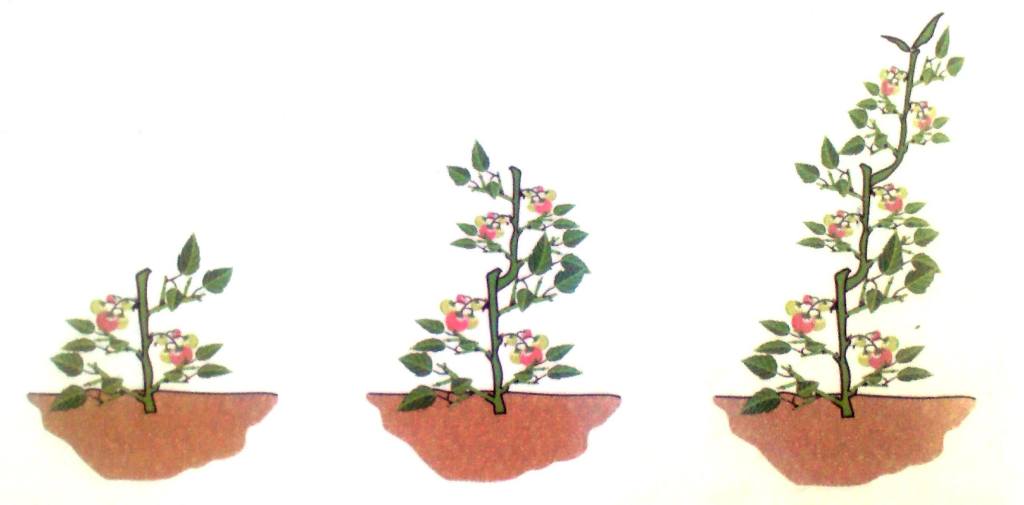
How long does it take to produce a tomato plant?
Approximately two months after transplanting, the first tomatoes will begin to be ready, and they will not stop producing until the end of summer. Go collecting them as they turn red.
If there are green tomatoes left on the bushes at the end of the season, cut the plants at their base and hang them upside down in a sheltered place until they mature.
To enjoy all its flavor, consume ripe tomatoes as soon as they are harvested. If you have many, you can always make preserves such as jams or fried tomato. You can also freeze them, although in this case it will be better to use them for elaborate dishes or sauces, because, once thawed, they will have lost their firmness.
Another problem when growing tomatoes can be the difficulties of pollinating the flowers (especially in urban gardens, with little presence of bees, bumblebees and other insects that usually carry out this pollination task). If this happens, many flowers will dry up and will not produce tomatoes. You can collaborate in pollination by passing a brush with pollen from one flower to another, releasing bumblebees or installing a pollinator station.
Tomato pests, diseases and other problems
- Most common tomato pests: whitefly, aphid, red spider, thrips, caterpillars (such as Heliotis) and potato cyst nematodes.
- Tomato diseases: typical orchard fungi (mildew, powdery mildew and botrytis), potato mosaic virus and leaf mold.
(Find out how to combat them by reading the articles in the «Pests and diseases» category, we have files on all the pests in the garden)
In the post on Common Tomato Pests and Diseases you have more details on the problems you may encounter when growing tomatoes.
Other problems in tomato cultivation
It is important to maintain the soil with a constant humidity, without great differences (NO alternation of dry periods and wet periods). Irregular irrigation can affect the fruit, causing it to crack and favoring the appearance of a problem called rot or blossom-end rot (which is also related to the use of a substrate that is too acidic and poor in Calcium).
If you see the “rotten ass tomatoes” this could be due to Calcium deficiency. To avoid blossom-end rot due to lack of calcium, there are some natural remedies.
I leave you this video in which Álvaro explains to us in an entertaining and fun way how to avoid rotten asses or apical rot in tomatoes.
References
- Reche Marmol, J., 1998. Pruning Vegetables in Greenhouses (Eggplant, Pepper and Tomato). Divulging Sheets, nº 2094 HD. Ministry of Agriculture, Fisheries and Food (Spain).
- Bogotá Chamber of Commerce, 2015. Manual: Tomato. Agricultural and Agroindustrial Support Program.
- Macua González, JI et al., 2017. Outdoor horticultural crops: Tomato. Cajamar Publications Caja Rural. Agricultural Series, No. 13, p. 437-470.

